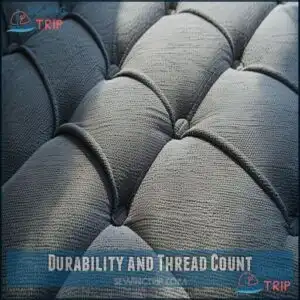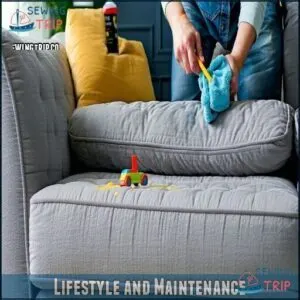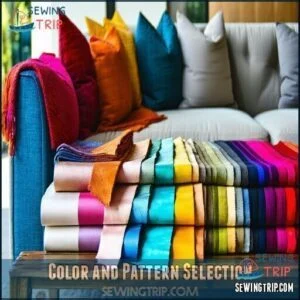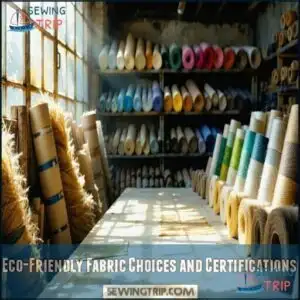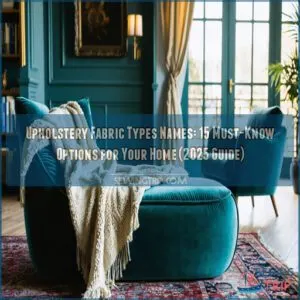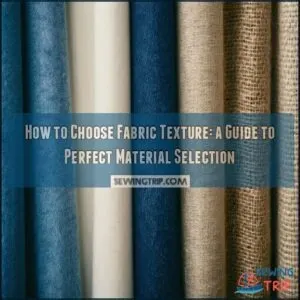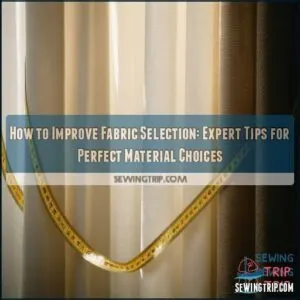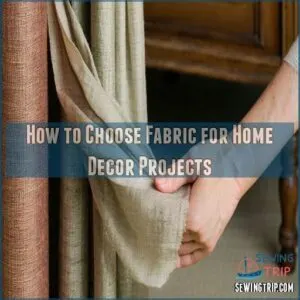This site is supported by our readers. We may earn a commission, at no cost to you, if you purchase through links.

First, think about your lifestyle—kids, pets, or wine nights call for tough, stain-resistant options like microfiber or treated cotton.
Natural fabrics like linen or wool feel luxurious but may require more upkeep, while synthetics like polyester offer easy maintenance and durability.
Look for a high thread count or tight weave for long-lasting performance, and consider colors or patterns that hide wear and stains.
If fading’s a concern, opt for fade-resistant finishes.
To truly match your pieces, explore textures and styles that fit your decor.
There’s more to uncover!
Table Of Contents
Key Takeaways
- Think about your lifestyle and pick fabrics that can handle kids, pets, and spills, like microfiber or treated cotton.
- Choose durable fabrics with a tight weave and consider fade-resistant options for long-lasting performance.
- Match your furniture’s style with colors or patterns that hide wear and stains while reflecting your decor.
- Opt for sustainable or certified eco-friendly fabrics to balance style, practicality, and environmental impact.
Choosing Upholstery Fabric
When choosing upholstery fabric, you’ll want to focus on balancing durability, style, and comfort to suit your needs.
Consider factors like the fabric’s type, usage, and maintenance requirements to guarantee it performs well in your space.
Fabric Types and Characteristics
When choosing upholstery fabric, the right type depends on your needs.
Natural fabrics like cotton and wool offer breathability, while synthetic fabrics, such as polyester, resist wear.
Pay attention to fabric weaves and blends, as they impact durability and texture.
- Natural fibers: Breathable, soft, timeless.
- Synthetic fibers: Stain-resistant, low-maintenance.
- Cleaning codes: Guarantee easy care methods.
Natural Vs Synthetic Fabrics
Natural fibers like cotton and linen offer elegance and breathability but wrinkle easily, while synthetic fibers like polyester resist fading and wear.
For fabric durability, the weave and quality matter more than cost alone. Texture differences can influence comfort, with leather being smooth and vinyl more practical.
Durability lies in the weave and quality, where texture defines comfort—leather offers smooth luxury, while vinyl delivers practical resilience.
Synthetic fibers excel in wear and tear resistance, making them ideal for high-use upholstery. Balancing environmental impact with best uses guarantees your furniture fits your lifestyle.
Factors in Choosing Upholstery Fabric
When picking upholstery fabric, weigh usage considerations and fabric durability.
Heavy-use pieces need stain resistance and durable textures.
Consider color psychology—neutral tones hide wear better.
Always assess maintenance needs; some fabrics require more care.
Don’t forget allergy concerns—hypoallergenic types help sensitive families.
Think practically; explore upholstery fabric types that merge style with functionality for lasting comfort and beauty.
How to Choose Upholstery Fabric
Choosing the right upholstery fabric requires balancing durability, style, and comfort to meet your needs.
Start by evaluating the intended use of your furniture, traffic levels, and maintenance preferences to guarantee a practical and long-lasting choice.
Key Challenges And Opportunities
With upholstery, you’ll face challenges like balancing fabric durability, stain resistance, and fabric cost.
Supply chain issues influence affordability, while skilled labor shortages impact quality.
Sustainability goals push eco-friendly choices, but options can be limiting.
Educating yourself and others about materials simplifies decisions.
Here’s a quick look at challenges and opportunities:
| Challenge | Opportunity | Key Tip |
|---|---|---|
| Fabric cost | Budget-friendly | Compare materials |
| Stain resistance | Treated fabrics | Choose wisely |
| Skilled labor | Quality assurance | Support local artisans |
| Sustainability | Longer-lasting | Seek certifications |
| Consumer education | Smarter choices | Learn before buying |
Future Trends And Innovations
Smart fabrics are reshaping upholstery, offering features like self-cleaning textiles and temperature control.
Self-cleaning textiles and temperature control innovations are revolutionizing upholstery, merging cutting-edge convenience with style and practicality for modern living.
Sustainable materials, including recycled fibers, lead eco-friendly innovations.
Upholstery fabric trends now embrace 3D printing for precise patterns and textures, while performance enhancements guarantee durability and comfort.
These fabric innovations combine style with practicality, making eco-friendly materials and advanced technology key to future-oriented designs that balance beauty and functionality.
Real-World Applications And Impact
In everyday use, fabric selection impacts durability, comfort, and cost analysis.
Healthcare settings demand upholstery fabric types with stain resistance and easy cleaning for hygiene, while public spaces require durable, pet-friendly fabric.
Considering environmental impact, eco-friendly options like recycled fibers shine. Balancing fabric durability with style guarantees versatility across needs, whether for busy families or professional environments.
Fabric Selection Factors
When choosing upholstery fabric, you’ll need to weigh factors like durability, maintenance, and how the fabric fits your lifestyle.
Balancing thread count, color, and patterns makes certain the material works both practically and aesthetically for your space, considering your lifestyle.
Durability and Thread Count
When choosing upholstery fabric, durability and thread count are your allies.
Focus on wear resistance and know the fabric’s Martindale Rub Count or Double Rubs score. A dense weave enhances Fiber Strength and Abrasion Resistance.
Consider exploring options for dense weave upholstery for enhanced longevity.
Always check:
- Weave Density: Tighter weaves last longer.
- Fabric Lifespan: High thread counts improve durability.
- Fiber Strength: Resists damage.
- Performance Labels: Confirm robustness.
Lifestyle and Maintenance
When choosing fabric, think about how your family uses the furniture.
Kid-friendly fabrics with stain protection or pet-friendly options with wear resistance are great for busy homes.
Cleaning upholstery regularly extends fabric lifespan—vacuum often and blot spills immediately.
Consider specialized cleaning products for superior care.
Select materials with easy cleaning methods, as proper fabric maintenance guarantees your pieces stay comfortable and stylish for years.
This approach ensures that your furniture remains in good condition, making it a worthwhile investment for your home, with busy homes in mind.
Color and Pattern Selection
After considering maintenance needs, think about how colors and patterns shape your space.
A room palette sets a tone—neutral hues offer flexibility, while bold colors make statements.
Pattern matching creates harmony, and pattern scale balances furniture size.
Use color psychology to evoke mood, and darker fabric colors with visual texture and fabric patterns work wonders for hiding stains beautifully.
Key Considerations for Fabric
When choosing upholstery fabric, it’s important to balance durability, style, and practicality to match your furniture’s use.
Consider factors like pet and child-friendliness, eco-certifications, and maintenance needs to guarantee your fabric choice holds up over time.
Pet-Friendly Fabrics and Options
When pets share your furniture, durability and comfort matter.
Opt for pet-friendly fabrics like microfiber or treated leather, offering scratch resistance and cleaning ease.
High weave density adds durability, while stain protection and odor control keep your upholstery fresh.
Avoid loose weaves or delicate materials; they snag easily.
A well-chosen fabric guarantees your pets and furniture coexist happily.
For superior protection, consider durable denim options.
Child-Friendly Fabrics and Coatings
Just as your furry friends need special fabric considerations, your little ones require thoughtful upholstery choices too.
For child-friendly fabrics, look for washable, stain-resistant options with non-toxic treatments. Microfiber and treated cotton blends offer durability while maintaining softness against sensitive skin.
Performance fabrics like Crypton and Sunbrella provide built-in protection—they’ll withstand juice spills, marker mishaps, and sticky fingers without sacrificing style or comfort in your family spaces.
You can also find excellent upholstery fabric options online.
Eco-Friendly Fabric Choices and Certifications
The earth’s future benefits when you select eco-friendly materials for your furniture.
Look for organic cotton certified by GOTS, which requires 70% organic content throughout the supply chain. Hemp upholstery offers a sustainable alternative to conventional natural fabrics.
Verify sustainable certifications like FSC for wood-based fibers, RWS for responsible wool sourcing, and BCI for eco-conscious cotton.
Recycled fibers and natural dyes further reduce environmental impact.
Practical Tips for Fabric Selection
You’ll find the most appropriate upholstery fabric by consulting industry experts and carefully reviewing manufacturer warranties before making your final decision.
When selecting fabric, don’t hesitate to ask professionals about fabric performance in real-world settings and examine guarantee terms that indicate the manufacturer’s confidence in their product’s durability.
Consulting Experts and Manufacturers
Fabric consultants serve as your upholstery compass, offering expert advice customized to your specific needs.
Contact reputable fabric manufacturers like Kravet, Robert Allen, or Valdese Weavers for personalized consultation and custom options.
For bag projects, remember that canvas offers durability.
- Request fabric samples from suppliers to test durability and color in your home environment
- Review manufacturer catalogs for detailed fabric specifications and performance ratings
- Schedule expert consultation sessions with specialists who understand technical fabric requirements
Considering Warranties and Guarantees
Manufacturer warranties can save you headaches, but read the fine print to uncover hidden exclusions.
Look for warranty coverage that includes fabric durability testing and fading or stain resistance testing. Guarantee types vary, so ask about the claim process upfront.
Evaluating long-term value—especially for high-use furniture—helps avoid surprises later. Reliable fabric wear resistance guarantees peace of mind for years.
Many warranties cover manufacturer defects, ensuring items are free from blemishes and imperfections.
Maintaining Upholstery Fabric
Keeping your upholstery fabric in great shape requires consistent care, including regular vacuuming and prompt attention to stains.
Protecting it from sunlight and rotating cushions will also help extend its lifespan and maintain its appearance.
This will also help with consistent care, and overall maintenance of the fabric.
Regular Vacuuming and Spot Cleaning
Regular vacuuming with proper vacuum settings prevents dirt buildup and helps maintain fabric care.
Address spills quickly; dab, don’t scrub, to avoid damage. Use fabric-safe cleaning solutions as per cleaning instructions for effective stain removal.
For tough stains, professional cleaning guarantees thorough care. Follow fabric stain resistance guidelines to prolong your upholstery’s life and keep it looking fresh.
Avoiding Direct Sunlight and Fading
Shielding upholstery from sunlight exposure keeps colors vibrant and prevents fabric fading.
Use window treatments or UVresistant fabrics for protection. Opt for materials with natural fade resistance and dye resistance for long-term color retention.
Rotate furniture away from windows, or add translucent film for UV protection. These steps help maintain the beauty and extend your upholstery’s life.
- Install curtains or blinds.
- Choose UVresistant fabrics.
- Use window films for UV protection.
- Reposition furniture periodically.
Rotating Cushions and Prolonging Lifespan
Give your cushions a fighting chance by rotating them regularly.
This helps balance cushion wear, guaranteeing even support and reducing fabric stress.
Rotating cushions keeps shape retention intact while extending furniture life.
Upholstery fabric ages gracefully with proper care, and this simple habit boosts wear resistance.
Think of it as maintenance that helps prolong fabric lifespan for daily furniture use.
To guarantee longevity, it’s vital that you examine fabric durability ratings to ensure your furniture receives the proper care it needs for extended life.
Frequently Asked Questions (FAQs)
How do I choose upholstery fabric?
Start by considering durability, color, pattern, and maintenance.
Match fabric strength to use—durable for kids or pets, delicate for formal rooms.
Test swatches at home for feel and look under lighting.
What is the best material to reupholster a couch with?
Choose durable, stain-resistant materials like microfiber, leather, or performance fabrics for reupholstering a couch.
These options handle wear and tear, resist spills, and fit high-traffic spaces, offering both practicality and style for a refreshed look, with durable materials being key to the design.
What is the most durable fabric for upholstery?
If durability is your priority, microfiber, leather, and olefin are top choices.
Microfiber resists stains and fading, leather ages beautifully with care, and olefin combats wear, stains, and sunlight, making them ideal for heavy use, with microfiber and olefin being particularly notable for their resistance to stains.
How can upholstery protect against allergens or pests?
You wouldn’t believe how upholstery acts like an invisible shield.
Pick hypoallergenic fabrics, like microfiber, that resist dust mites and mold.
Add tight weaves, protective treatments, and regular cleaning to create a pest-free, allergen-safe sanctuary.
What upholstery fabrics work best in humid climates?
In humid climates, go for synthetic fabrics like olefin or microfiber—they resist mildew and moisture while staying durable.
Avoid natural fibers like linen, which absorb humidity and wrinkle easily, making maintenance a tricky affair, as they are not as resistant to moisture as synthetic options.
Are there fabrics that improve indoor air quality?
Natural fabrics like organic cotton or wool act like nature’s air filters, reducing toxins and allergens in your home.
Treated with eco-friendly finishes, they enhance breathability and freshness, creating a healthier indoor air environment with natural fabrics.
How do different fabrics affect seating comfort?
The fabric you choose shapes seating comfort.
Soft options like cotton and velvet feel cozy but may lack support, while leather offers firm luxury.
Microfiber balances softness and durability, making it great for everyday lounging with its softness.
What role does fabric sustainability play in choices?
Choosing sustainable upholstery fabric means supporting eco-friendly solutions.
It reduces environmental harm through recycled materials, organic fibers, or certifications.
You’re creating a greener home while enjoying guilt-free comfort, durability, and style—everyone wins, including the planet!
Conclusion
Selecting the right upholstery fabric doesn’t have to feel overwhelming.
Imagine a microfiber sofa standing up to wine spills or a fade-resistant armchair retaining its color in sunny rooms.
By balancing durability, style, and practicality, you can find options suited to your lifestyle and decor.
Consider thread count, patterns that hide wear, and eco-friendly choices for added value.
With these tips on how to choose upholstery fabric, you’ll create furniture that’s both beautiful and long-lasting.
- https://www.simshilditch.com/
- https://www.fabricsandfindings.com/upholstery-questions-to-consider
- https://furnitureconcepts.com/furniture-warranties-what-does-it-really-cover/
- https://www.theguestroomfurniture.com/furniture-warranties-what-you-should-know/
- https://www.ldiinteriors.com/wp-content/uploads/Not-All-Upholstery-Warranties-Are-Equal.pdf


